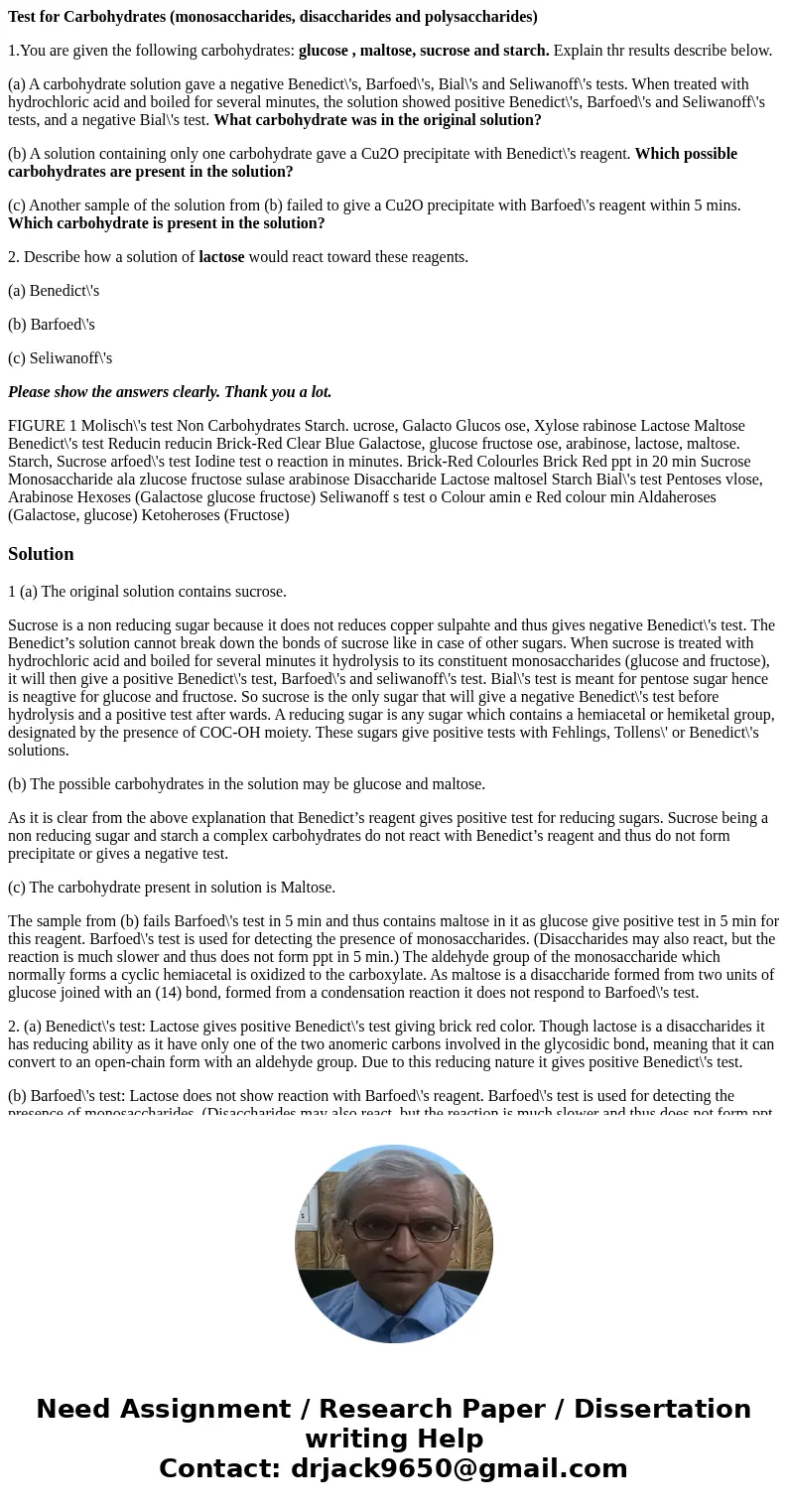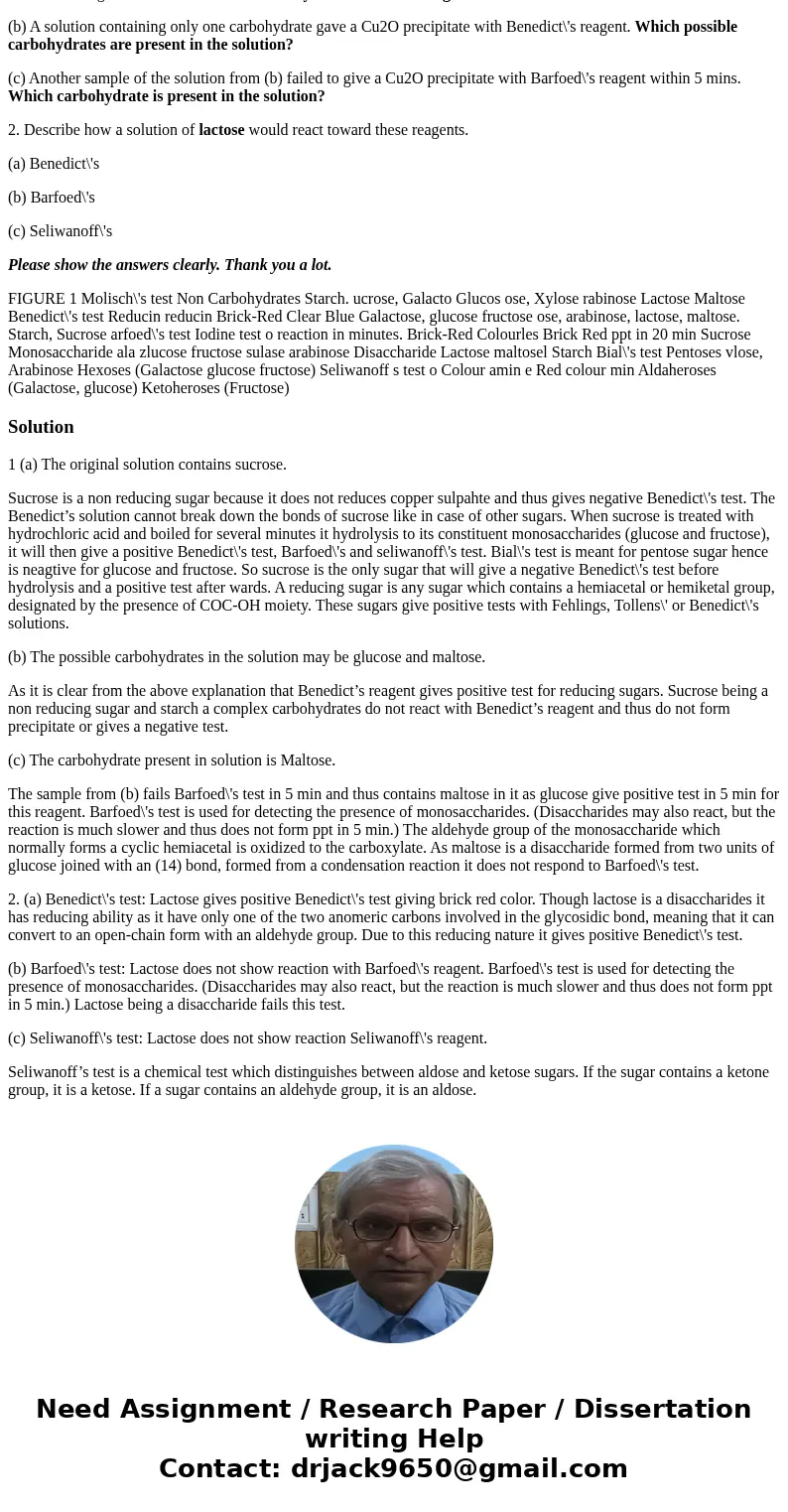Test for Carbohydrates monosaccharides disaccharides and pol
Test for Carbohydrates (monosaccharides, disaccharides and polysaccharides)
1.You are given the following carbohydrates: glucose , maltose, sucrose and starch. Explain thr results describe below.
(a) A carbohydrate solution gave a negative Benedict\'s, Barfoed\'s, Bial\'s and Seliwanoff\'s tests. When treated with hydrochloric acid and boiled for several minutes, the solution showed positive Benedict\'s, Barfoed\'s and Seliwanoff\'s tests, and a negative Bial\'s test. What carbohydrate was in the original solution?
(b) A solution containing only one carbohydrate gave a Cu2O precipitate with Benedict\'s reagent. Which possible carbohydrates are present in the solution?
(c) Another sample of the solution from (b) failed to give a Cu2O precipitate with Barfoed\'s reagent within 5 mins. Which carbohydrate is present in the solution?
2. Describe how a solution of lactose would react toward these reagents.
(a) Benedict\'s
(b) Barfoed\'s
(c) Seliwanoff\'s
Please show the answers clearly. Thank you a lot.
FIGURE 1 Molisch\'s test Non Carbohydrates Starch. ucrose, Galacto Glucos ose, Xylose rabinose Lactose Maltose Benedict\'s test Reducin reducin Brick-Red Clear Blue Galactose, glucose fructose ose, arabinose, lactose, maltose. Starch, Sucrose arfoed\'s test Iodine test o reaction in minutes. Brick-Red Colourles Brick Red ppt in 20 min Sucrose Monosaccharide ala zlucose fructose sulase arabinose Disaccharide Lactose maltosel Starch Bial\'s test Pentoses vlose, Arabinose Hexoses (Galactose glucose fructose) Seliwanoff s test o Colour amin e Red colour min Aldaheroses (Galactose, glucose) Ketoheroses (Fructose)Solution
1 (a) The original solution contains sucrose.
Sucrose is a non reducing sugar because it does not reduces copper sulpahte and thus gives negative Benedict\'s test. The Benedict’s solution cannot break down the bonds of sucrose like in case of other sugars. When sucrose is treated with hydrochloric acid and boiled for several minutes it hydrolysis to its constituent monosaccharides (glucose and fructose), it will then give a positive Benedict\'s test, Barfoed\'s and seliwanoff\'s test. Bial\'s test is meant for pentose sugar hence is neagtive for glucose and fructose. So sucrose is the only sugar that will give a negative Benedict\'s test before hydrolysis and a positive test after wards. A reducing sugar is any sugar which contains a hemiacetal or hemiketal group, designated by the presence of COC-OH moiety. These sugars give positive tests with Fehlings, Tollens\' or Benedict\'s solutions.
(b) The possible carbohydrates in the solution may be glucose and maltose.
As it is clear from the above explanation that Benedict’s reagent gives positive test for reducing sugars. Sucrose being a non reducing sugar and starch a complex carbohydrates do not react with Benedict’s reagent and thus do not form precipitate or gives a negative test.
(c) The carbohydrate present in solution is Maltose.
The sample from (b) fails Barfoed\'s test in 5 min and thus contains maltose in it as glucose give positive test in 5 min for this reagent. Barfoed\'s test is used for detecting the presence of monosaccharides. (Disaccharides may also react, but the reaction is much slower and thus does not form ppt in 5 min.) The aldehyde group of the monosaccharide which normally forms a cyclic hemiacetal is oxidized to the carboxylate. As maltose is a disaccharide formed from two units of glucose joined with an (14) bond, formed from a condensation reaction it does not respond to Barfoed\'s test.
2. (a) Benedict\'s test: Lactose gives positive Benedict\'s test giving brick red color. Though lactose is a disaccharides it has reducing ability as it have only one of the two anomeric carbons involved in the glycosidic bond, meaning that it can convert to an open-chain form with an aldehyde group. Due to this reducing nature it gives positive Benedict\'s test.
(b) Barfoed\'s test: Lactose does not show reaction with Barfoed\'s reagent. Barfoed\'s test is used for detecting the presence of monosaccharides. (Disaccharides may also react, but the reaction is much slower and thus does not form ppt in 5 min.) Lactose being a disaccharide fails this test.
(c) Seliwanoff\'s test: Lactose does not show reaction Seliwanoff\'s reagent.
Seliwanoff’s test is a chemical test which distinguishes between aldose and ketose sugars. If the sugar contains a ketone group, it is a ketose. If a sugar contains an aldehyde group, it is an aldose.


 Homework Sourse
Homework Sourse